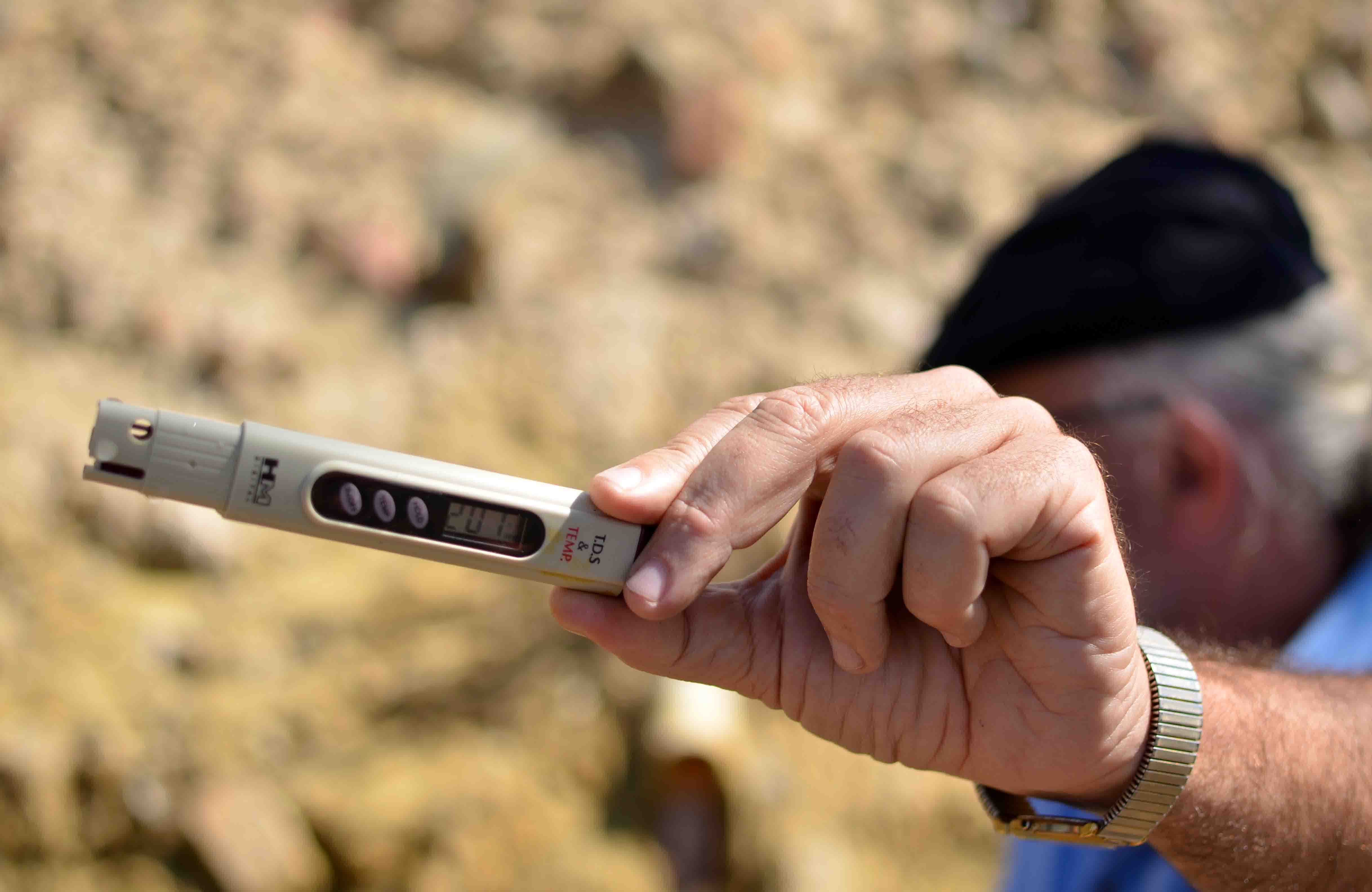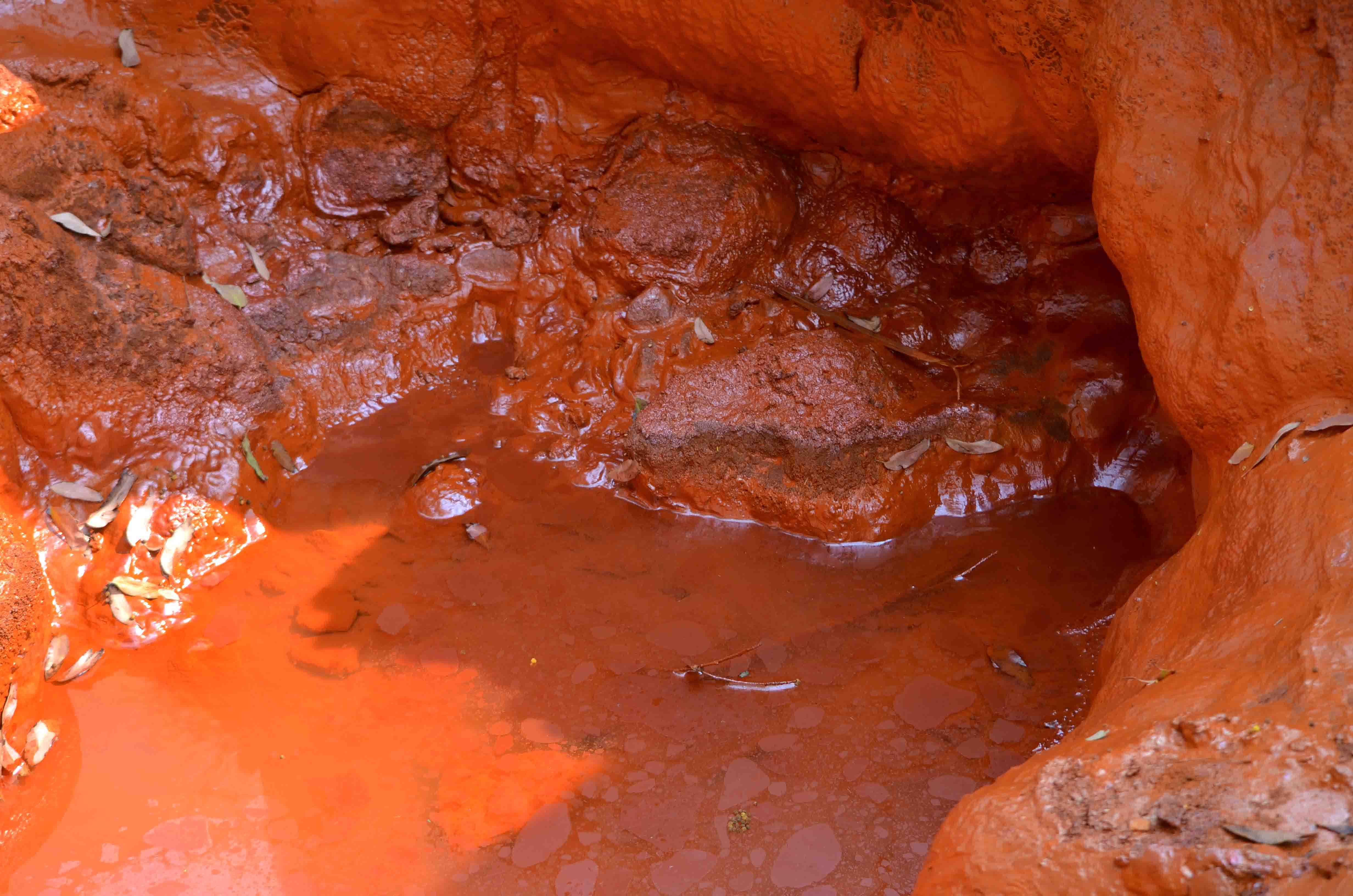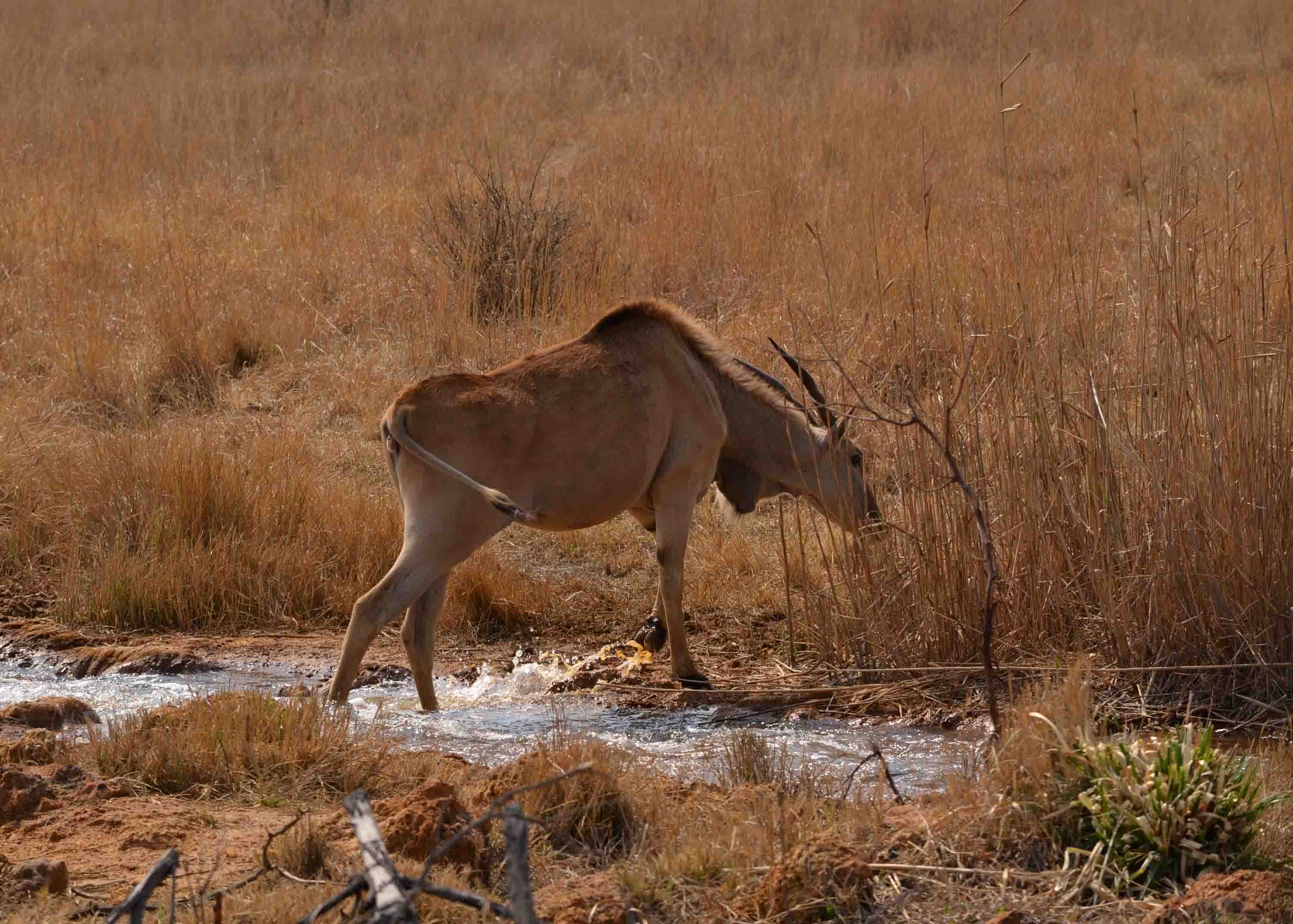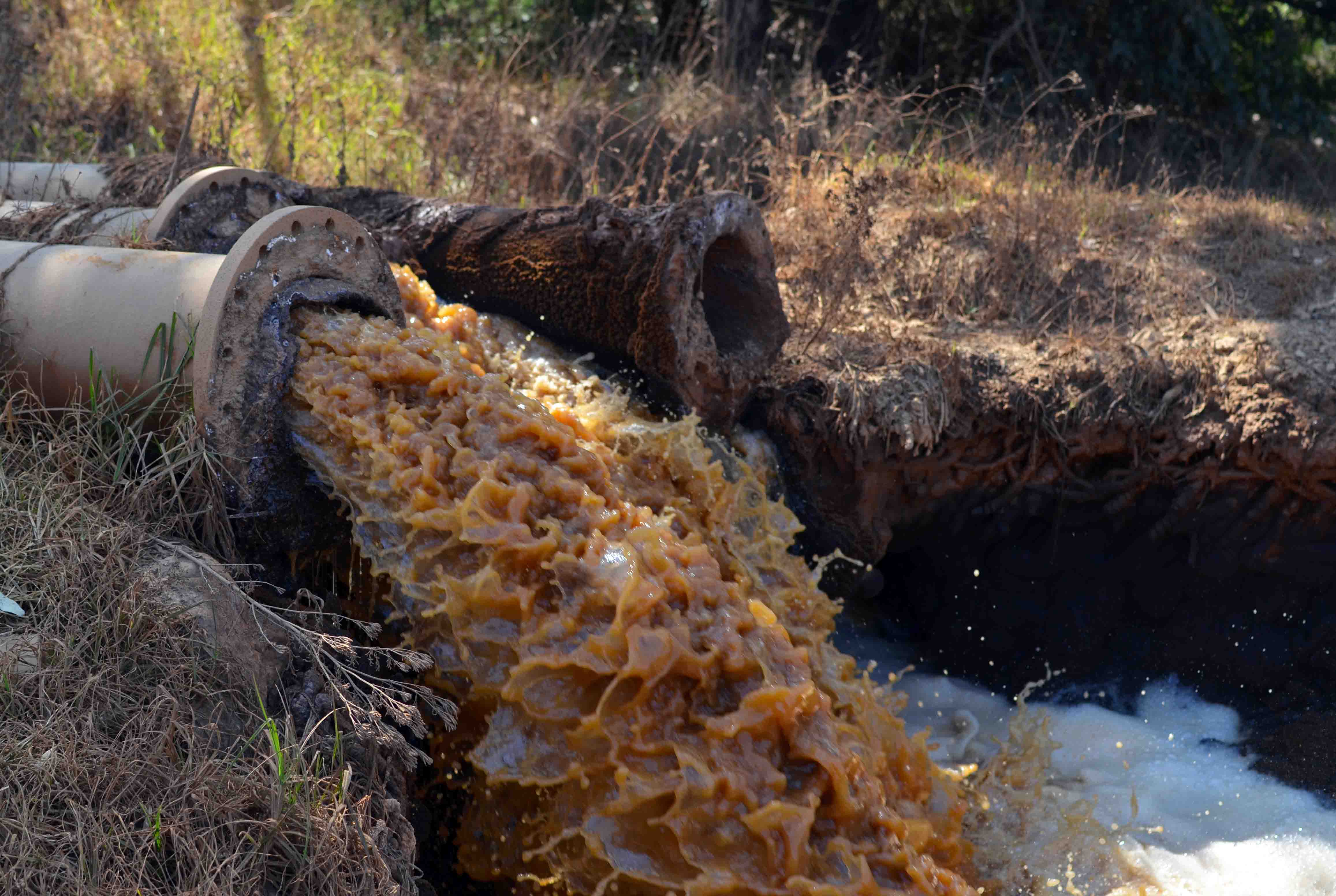
13 Nov SA’s water bubble
Added to the crippling drought in South Africa are mining’s long-term impacts on water security. Mark Olalde investigates the costly legacy of historic mine waste

Acid mine drainage decants at the 18 Winze shaft on the West Rand. According to the Council for Scientific and Industrial Research, up to 20% of stream flow around Johannesburg may originate from polluted groundwater. Photos © Mark Olalde
The acid mine drainage decanted in a trickle out of 18 Winze shaft in Krugersdorp, on Gauteng’s West Rand. Rising above ground level, orange sludge bubbled alongside rusted pipes.
Nearby a converted Rand Uranium plant pumped acid mine water and lime into a treatment pit. This treated water reconnected with groundwater downstream and flowed into the Krugersdorp Game Reserve, where animals such as elands were drinking from a stream lined with metal precipitate on both banks.
Not all acid mine drainage is visible, but it is one of the main difficulties of managing polluted underground voids left by 6,000 derelict and ownerless mines across South Africa.
“Mining legislation covers active mining in this present day, but we also deal with the legacy of historic mine waste and this is where acid mine drainage has manifested as a result,” said Kerry Bobbins, a researcher at the Gauteng City-Region Observatory, a think-tank partnering the universities of Johannesburg and the Witwatersrand, and the Gauteng provincial government.
According to Bobbins, goals for rehabilitating derelict and ownerless mines are often not met. Water pumped out of the mines can have huge impacts on nearby water systems, leading to an increase in suspended solids in the water and mobilising metals such as aluminium, cadmium, cobalt, iron, manganese and zinc.

An eland in the Krugersdorp Game Reserve crosses a stream coated on both shores by sludge from treated mine water. The current ‘pump and treat’ method drops metal precipitate out of mine water but does not significantly reduce the water’s salinity
‘Pump and treat’
The current method for dealing with acid mine water is called “pump and treat”. Water is pumped from the void and treated with lime to bring up the pH level and cause heavy metals to drop out. The method is expensive and does not address the water’s high salinity, critics say.
“It’s also affecting our potable water supply, and it’s now got to the point at which we are facing a really big water security concern in the region,” Bobbins said.
Gauteng relies on the Lesotho Highlands Water Project for clean water, and some of that water is used to dilute acid mine drainage. The project’s first phase is complete and the second will bring more water into the system, but not until 2020.
“Until phase two comes online, we are likely going to face a significant decrease in water quality,” Bobbins said.
Especially in the Vaal River system, the high salinity created by acid mine drainage (AMD) flowing from mines threatens water resources.
“Should the AMD issue, and specifically the desalination, not be addressed appropriately by 2014/15, the acceptable levels of assurance of water supply will be threatened. This means there will be an increasing risk of water restrictions in the Vaal River water supply area,” stated a 2012 consultant’s report for the Department of Water and Sanitation.

Treated acid mine water spews out of pipes on its way to a holding pit in Krugersdorp. The deceivingly clear acid mine water turns cloudy after being treated with lime
Costs of AMD
Marius Keet, the department’s senior manager, said short-term solutions to acid mine drainage had cost the department R2-billion by earlier this year, and it could cost an additional R10-billion to build desalination plants.
The Council for Scientific and Industrial Research (CSIR) warned that in 2000 already 10 of the nation’s 19 water management areas could not meet demand. High levels of pollution were worsening the problem of water access, the council said.
A 2003 CSIR report found as much as 20% of the stream flow around Johannesburg came from polluted groundwater, and pollution from mines can affect water up to 10km away.
In 2014 a report by the South African Human Rights Commission rated 9% of the country’s municipalities as being in a “crisis state” with regards to water services, with a significant risk of disease outbreak as a result. A further 38% had “high risk.”
Up to one in five rural communities are estimated not to have reliable access to water, according to the commission.
“In these rural areas you find many mining companies,” said Mariette Liefferink, chief executive of the Federation for a Sustainable Environment. “They adjust the water table, and they pollute the water with impunity while communities go without.”
South Africa is the 30th driest country in the world, the Department of Water and Sanitation reported in the 2013/14 South African Yearbook. “South Africa’s water resources are, in global terms, scarce and extremely limited,” it noted.
By 2030 there will be a 17% gap between water supply and demand, predicts environmental NGO Greenpeace. A shortfall of some 2.7-billion cubic metres could have the effect of tripling water prices.
And prices for the resource will keep rising: Treasury estimated in 2012 that annual increases of between 10% and 15% will be needed in the national budget to match growing demand for water.
“Most of South Africa’s water is used by business, especially agribusiness, mining and other industries, at a relatively lower cost per kilolitre than poor households. By not holding businesses that pollute and waste water to account, government is not protecting water as a basic human right,” the Human Rights Commission report found. The report noted that 39 mines were operating in 2014 without water use licences.

David van Wyk of the Bench Marks Foundation tests the total dissolved solids in water flowing out of tailings piles near Soweto. ‘It burns my skin where the water dropped on it,’ van Wyk said. ‘This is an externalised cost of mining.’
Costs of AMD
The Department of Water and Sanitation, which is in charge of issuing mining companies with water licences, did not respond to questions submitted by Oxpeckers about mining’s impacts on water and the effectiveness of the current acid mine drainage treatment.
Frank Winde is at the forefront of the acid mine drainage debate from his post as a professor at North-West University. He said pollution problems would only worsen as several mining sectors continued to wind up.
“There are no contingency plans. There are no preparations, there is no proactive management,” Winde said. “I haven’t seen any government authority demanding what is going to happen once all mines close.”
Under the derelict and ownerless mines are voids where underground chambers were once compartmentalised, and above the mines six billion tonnes of mine waste have been dumped on the Witwatersrand alone. While the voids allow water to flow through the mining basin, the dumps significantly contribute to acid mine drainage.
“Even if there’s no rain, there’s a permanent supply of seepage out of those dumps,” Winde said. Rivers receive a large amount of flow from this seepage before flowing back into the voids.
Coal production has been increasing in recent years and with Eskom’s new coal-fired power plants coming online, impacts on already water-strained areas in Limpopo and Mpumalanga provinces will grow.
Eskom accounts for two percent of the nation’s water use, enough to fill an Olympic-sized swimming pool every four minutes. It produces 90% of its electricity through coal, accounting for some 90-million tonnes annually.
Winde said as the coal mining industry grew to match demand for coal, water pollution problems would grow and the government needed a better solution than “pump and treat” to deal with them.
“I regard ‘pump and treat’ as a very suboptimal type of solution. Why? Because, first of all it’s very expensive. And there’s no end to it. And it doesn’t address the cause of the problem,” Winde said.
“That is only the beginning of an eternal exercise.” – oxpeckers.org
#MineAlert: Find out about mining projects near you, and register for alerts, here
Mark Olalde is an American environmental journalist working on a mentorship programme with the Oxpeckers Centre for Investigative Environmental Journalism. His work in South Africa was supported by a grant from the Fund for Investigative Journalism, and he was hosted by the Centre for Sustainability in Mining and Industry at the University of the Witwatersrand
